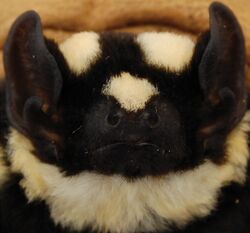Biology:Pied butterfly bat
| Pied butterfly bat | |
|---|---|

| |
| Scientific classification | |
| Domain: | Eukaryota |
| Kingdom: | Animalia |
| Phylum: | Chordata |
| Class: | Mammalia |
| Order: | Chiroptera |
| Family: | Vespertilionidae |
| Genus: | Glauconycteris |
| Species: | G. superba
|
| Binomial name | |
| Glauconycteris superba Hayman, 1939
| |

| |
| Synonyms | |
| |
The pied butterfly bat (Glauconycteris superba), also known as the pied bat or badger bat, is a rare species of vesper bat in the family Vespertilionidae.[2]
Taxonomy
First discovered in 1939 in Belgian Congo, the species was, at that time, placed in the genus Glauconycteris under the name Glauconycteris superba. Following a 2013 capture in South Sudan, only the fifth recorded capture of the species, the pied bat was relocated to an entirely new genus, Niumbaha, named after the Zande word for "rare".[3][4] Biology professor DeeAnn Reeder, one of the authors of the genus Niumbaha, said, "its cranial characters, its wing characters, its size, the ears – literally everything you look at doesn't fit. It's so unique that we need to create a new genus."[5] However, recognition of Niumbaha renders Glauconycteris paraphyletic and it is incorrect to treat Niumbaha as a valid genus without further splitting of Glauconycteris.[6] Due to this, both taxa have once again been synonymized.[7]
Description
The distinctive pied bat partly resembles a bee, with light yellow stripes and blotches on its body.
Geographic range
It is found in the Democratic Republic of the Congo, Ivory Coast, Ghana, Equatorial Guinea and South Sudan.[4] Its natural habitats are subtropical or tropical moist lowland and dry forests.
References
- ↑ Monadjem, A.; Cotterill, F.P.D.; Jacobs, D.; Taylor, P.J.; Fahr, J. (2017). "Glauconycteris superba". IUCN Red List of Threatened Species 2017: e.T44799A22069930. doi:10.2305/IUCN.UK.2017-2.RLTS.T44799A22069930.en. https://www.iucnredlist.org/species/44799/22069930. Retrieved 16 November 2021.
- ↑ Simmons, N.B. (2005). "Order Chiroptera". in Wilson, D.E.; Reeder, D.M. Mammal Species of the World: A Taxonomic and Geographic Reference (3rd ed.). Johns Hopkins University Press. p. 487. ISBN 978-0-8018-8221-0. OCLC 62265494. http://www.departments.bucknell.edu/biology/resources/msw3/browse.asp?id=13802203.
- ↑ Platt, J. R. (2013-04-11). "Beautiful Striped Bat Identified as Entirely New Genus". Scientific American blogs. Scientific American. http://blogs.scientificamerican.com/extinction-countdown/2013/04/11/beautiful-striped-bat-identified-new-genus/.
- ↑ 4.0 4.1 Reeder, D.; Helgen, K. M.; Vodzak, M.; Lunde, D.; Ejotre, I. (2013). "A new genus for a rare African vespertilionid bat: Insights from South Sudan". ZooKeys (285): 89–115. doi:10.3897/zookeys.285.4892. PMID 23805046.
- ↑ "Striped like a badger: New genus of bat identified in South Sudan" (in en). ScienceDaily. https://www.sciencedaily.com/releases/2013/04/130409111603.htm.
- ↑ Hassanin, Alexandre; Colombo, Raphaël; Gembu, Guy-Crispin; Merle, Marie; Tu, Vuong Tan; Görföl, Tamás; Akawa, Prescott Musaba; Csorba, Gábor et al. (2018). "Multilocus phylogeny and species delimitation within the genus Glauconycteris (Chiroptera, Vespertilionidae), with the description of a new bat species from the Tshopo Province of the Democratic Republic of the Congo" (in en). Journal of Zoological Systematics and Evolutionary Research 56: 1–22. doi:10.1111/jzs.12176.
- ↑ "Explore the Database". https://www.mammaldiversity.org/explore.html#species-id=1005546.
External links
Wikidata ☰ Q1831959 entry
 |


